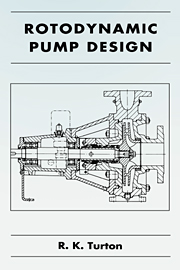Book contents
- Frontmatter
- Contents
- Preface
- Symbols
- 1 Fundamental principles
- 2 Cavitation in pumps
- 3 Centrifugal pump principles
- 4 Principles of axial and mixed flow pumps
- 5 Flow calculations in pumps and an introduction to computer aided techniques
- 6 Single stage centrifugal pump design
- 7 The design of axial and mixed flow pumps
- 8 Basic design principles of shafts, bearings and seals, and selection of drive
- 9 Pump design for difficult applications
- 10 An introduction to the next stage in the pump design process
- References
- Index
10 - An introduction to the next stage in the pump design process
Published online by Cambridge University Press: 29 September 2009
- Frontmatter
- Contents
- Preface
- Symbols
- 1 Fundamental principles
- 2 Cavitation in pumps
- 3 Centrifugal pump principles
- 4 Principles of axial and mixed flow pumps
- 5 Flow calculations in pumps and an introduction to computer aided techniques
- 6 Single stage centrifugal pump design
- 7 The design of axial and mixed flow pumps
- 8 Basic design principles of shafts, bearings and seals, and selection of drive
- 9 Pump design for difficult applications
- 10 An introduction to the next stage in the pump design process
- References
- Index
Summary
Introduction
Chapters 1 to 7 have outlined the principles that underlie the successful design of the elements of the flow path in centrifugal, axial and mixed flow machines, and with the help of worked examples the logic to be followed has been explained. Chapter 8 has introduced the background to shaft design, seal and bearing system selection, and Chapter 9 has introduced the problems posed by difficult liquids, and the principles to be followed in choosing the correct materials and thickness of machine elements.
The first stage in the process of developing a pump is the establishing of the pump duty, which does not just mean the duty point but the fluid properties and other matters. Detail design is only complete when all the relevant standards and codes of practice are observed and satisfied. The discussion which follows covers these matters, and concludes with a brief discussion of test provisions and procedures.
Establishing the pump duty
An important factor in the process of producing the right pump design is the establishment of the pump duty. This demands a full interchange of information between the customer and the pump maker.
The pump designer requires to know, in addition to the rated flow rate, head and NPSHA, the environment in which the machine is to be operated, the probable range of flow rates and heads that are to be presented to the machine in the plant.
- Type
- Chapter
- Information
- Rotodynamic Pump Design , pp. 180 - 186Publisher: Cambridge University PressPrint publication year: 1994



